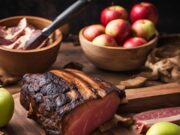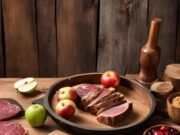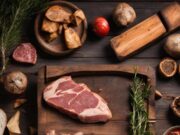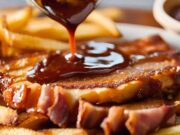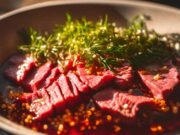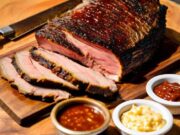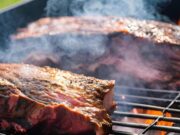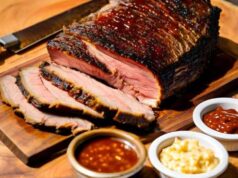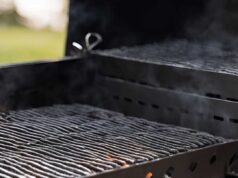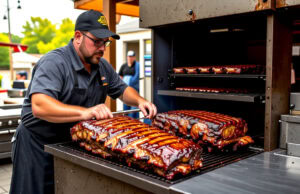Grilling is not merely a cooking method; it is an art form focused on selecting the perfect cut of meat.
Whether you are a seasoned pitmaster or a backyard BBQ enthusiast, choosing the right meat cut can significantly enhance your grilling experience.
This guide provides comprehensive information about BBQ meat cuts, including insights on marbling and tenderness, as well as budget-friendly options that do not compromise on flavor.
You will also find valuable cooking techniques and seasoning tips designed to elevate your BBQ skills. Prepare to take your grilling to the next level.
Key Takeaways:
- Choose the right cut of meat for your BBQ to enhance flavor and tenderness.
- Consider factors like marbling, tenderness, and fat content when selecting meat cuts for the grill.
- Don’t be afraid to experiment with different cuts of meat and cooking techniques to find your perfect BBQ combination.
The Ultimate Guide to BBQ Meat Cuts: Choosing the Best for Your Grill
The ultimate guide to BBQ meat cuts is crafted to assist you, whether you are a novice or an experienced griller, in understanding the intricacies of selecting the best meat for grilling and smoking.
With a wide array of options available, ranging from premium ribeye and strip steaks to more budget-friendly cuts like pork and flank, it is crucial to comprehend how different cuts influence tenderness, flavor, and cooking techniques.
By taking into account factors such as marbling, fat content, and cooking methods, you can enhance your BBQ experience, ensuring that each meal is not only delicious but also aligns with your budget and taste preferences.
This guide will delve into various methods and tips to help you achieve the perfect BBQ meat, guaranteeing that you enjoy juicy, flavorful results every time.
Understanding BBQ Meat Cuts
Understanding BBQ meat cuts is essential for anyone aiming to become an expert griller or smoker, as the right cut can significantly impact the overall quality and flavor of your meal.
Different cuts, whether premium selections like ribeye and brisket or more budget-friendly options like chicken and pork, each possess unique characteristics that determine their tenderness, marbling, and optimal cooking techniques.
When choosing the right cut, it’s important to not only understand the meat itself but also to consider how it will be prepared—whether through grilling, smoking, or roasting. This foundational knowledge will enable you to make informed decisions that enhance your BBQ experience and overall satisfaction.
What Are BBQ Meat Cuts?
BBQ meat cuts refer to various sections of meat sourced from animals, each providing distinct flavors and textures that significantly impact the grilling or smoking process. Understanding these cuts can elevate your backyard cookout.
For example, the ribeye is prized for its marbling and rich, beefy flavor, making it ideal for high-heat grilling. This technique renders the fat and results in a juicy, tender bite. In contrast, sirloin offers a leaner cut with a slightly firmer texture and a more subtle flavor, making it versatile for both grilling and marinating.
Brisket, known for its deep, smoky taste, requires low and slow cooking methods to break down tough fibers, delivering a melt-in-your-mouth experience. Each cut not only demands different techniques but also presents unique taste profiles that can be enhanced through specific seasonings and sauces, allowing for endless culinary creativity.
Importance of Choosing the Right Cut
Choosing the right cut of meat for BBQ is essential, as it directly affects the quality, tenderness, and overall flavor of the dish you are preparing.
Selecting various cuts, such as ribs, brisket, or sirloin, can significantly influence not only your grilling technique but also the enjoyment of your meal. For instance, tougher cuts like chuck typically require low and slow cooking methods to effectively break down the connective tissues, while tender cuts can be seared quickly over high heat.

The nuances in flavor also change dramatically based on the cut you choose, with marbling playing a critical role in delivering juiciness and richness. When weighing quality against price, it is prudent to seek cuts that offer the best value, such as flank steak or pork shoulder, which can yield gourmet results without straining your budget.
This knowledge enables you as a grill master to elevate your BBQ game, achieving that perfect balance of flavor and texture.
Factors to Consider When Choosing Meat Cuts
When selecting the ideal meat cut for BBQ, it is essential to consider several critical factors to ensure optimal flavor, tenderness, and overall satisfaction of your meal. Factors such as marbling, tenderness, and fat content are pivotal in determining how a cut will perform when grilled or smoked.
Marbling refers to the small flecks of fat within the meat that enhance both flavor and juiciness, while tenderness is influenced by the cut’s location on the animal and the handling it has received. By understanding these elements, you can make an informed choice that aligns with your cooking method and desired outcomes.
Marbling: The Key to Flavorful and Tender Grilled Meat
Marbling is essential in determining the flavor and tenderness of grilled meat, as it consists of intramuscular fat that melts during cooking, infusing the meat with rich flavors. This characteristic significantly enhances the overall eating experience.
When considering BBQ, cuts like ribeye and brisket are prime examples of high marbling. These intramuscular fat deposits render beautifully, resulting in a juicy and succulent texture. The higher the marbling, the more forgiving the meat is during the cooking process, allowing for better temperature control and improved moisture retention.
In contrast, leaner cuts, while healthier, often necessitate careful cooking to prevent dryness. Understanding the importance of marbling not only aids in selecting the right cut but also informs your grilling techniques, ensuring maximum flavor and tenderness with every bite.
Tenderness: What Determines Meat Tenderness?
Meat tenderness is influenced by various factors, including the cut’s location on the animal, its age, and how it has been processed and handled.
The breed of the animal and its diet also significantly affect the texture of the meat, leading to variations in tenderness between different types. Certain cuts, such as filet mignon and ribeye, are renowned for their buttery softness, making them ideal for quick cooking methods like grilling or pan-searing that preserve their juiciness.
On the other hand, cuts like brisket or chuck roast require longer cooking times at lower temperatures to effectively break down the connective tissues, ultimately enhancing their tenderness.
Understanding these nuances allows you to achieve the best results when preparing your favorite meat dishes.
Fat Content: Understanding Its Role in Flavor
The fat content in meat plays a crucial role in flavor and moisture retention during cooking, often determining whether a BBQ dish turns out juicy or dry.
This aspect is particularly important when selecting BBQ meat cuts, as varying levels of fat can significantly affect the overall eating experience. For example, cuts like brisket or pork belly, which are rich in intramuscular fat, typically yield a tender and flavorful outcome when smoked or grilled. In contrast, leaner cuts such as chicken breast or sirloin may require additional moisture enhancements, such as marinades or brines, to prevent them from drying out during cooking.
Understanding the balance of fat also helps in choosing suitable cooking methods; fatty cuts tend to excel in smoky environments, while lean options are better suited for quick, high-heat techniques. Therefore, recognizing the interplay between fat content and cooking methods is essential for achieving that ideal BBQ flavor and texture.
Best Cuts of Meat for BBQ
Selecting the best cuts of meat for BBQ can significantly enhance your grilling experience, offering superior flavor alongside satisfying tenderness and juiciness. Premium cuts such as ribeye, brisket, and filet mignon are highly regarded for their rich taste and marbling.
Alternatively, options like chicken and pork serve as budget-friendly alternatives that do not compromise on quality. By understanding the unique attributes of various cuts, you can make informed choices that will impress your guests and ensure the success of your BBQ events, whether you are grilling or smoking.
Premium Cuts of Meat for the Grill
Premium cuts of meat, such as ribeye, brisket, and filet mignon, are highly regarded by grilling enthusiasts for their exceptional flavor, tenderness, and the ability to impress even the most discerning BBQ connoisseurs.
Each of these exquisite options brings unique characteristics to the table, making them a prized choice for any cook. The ribeye, known for its marbling, delivers a rich, juicy bite that truly shines when grilled to medium-rare, allowing the fat to render beautifully.
Brisket, often recognized for its robust flavor, benefits from low and slow cooking methods such as smoking or braising, which ultimately tenderize the meat and infuse it with incredible depth. Meanwhile, the filet mignon, celebrated for its buttery succulence, excels when simply seared to maintain its tender profile; a light seasoning of salt and pepper is often sufficient to elevate its natural flavors.
By enjoying each cut with a complementary sauce or side, you can enhance the tasting experience, showcasing the best attributes of these premium meats.
Less Expensive Cuts: Quality on a Budget
Choosing less expensive cuts for BBQ can yield excellent quality and flavor without straining your budget, making it an appealing choice for both home cooks and BBQ enthusiasts.
These budget-friendly options not only allow for guilt-free indulgence but also unlock a world of culinary creativity on the grill. Cuts such as flank steak, pork shoulder, and chicken thighs often provide remarkable tenderness and flavor when prepared with the right techniques.
For example, marinating flank steak overnight in a blend of vinegar and spices can enhance its robust profile, while slow-cooking pork shoulder enables the connective tissues to break down, resulting in melt-in-your-mouth goodness.
Grilling chicken thighs over medium heat ensures they remain juicy and flavorful. A sprinkle of your favorite seasoning or a drizzle of homemade BBQ sauce can serve as the finishing touch, transforming these economical cuts into a standout dish at any gathering.
Cooking Techniques for BBQ Meat
Mastering the appropriate cooking techniques for BBQ meat is essential for achieving the ideal combination of tenderness and flavor, regardless of whether you choose to grill, smoke, or roast.
Grilling vs. Smoking: Which is Best?
Regarding BBQ, the debate between grilling and smoking is a frequent topic among enthusiasts, with each method providing distinct flavors and cooking experiences.
Grilling is generally a quicker cooking technique that employs high heat, making it ideal for steaks, burgers, and vegetables. This method allows for the smoky char and sear that many people appreciate.
In contrast, smoking takes a low-and-slow approach that requires patience and is perfect for larger cuts like brisket, ribs, or pork shoulder. These cuts absorb more complex flavors from the wood chips over an extended cooking period.
While grilling focuses on direct heat and quick caramelization, smoking leverages indirect heat and time, resulting in a more tender and flavor-infused outcome that can evoke rich, savory notes.
Understanding these differences enables you to make an informed choice based on the dish you are preparing and the desired flavor profile.
Tips for Smoking Meat
Smoking meat is a precise art that demands careful attention to detail, from selecting the appropriate wood chips to managing the temperature for optimal flavor infusion.
Plus these foundational aspects, it is essential to recognize how different types of wood can impart unique flavor profiles to the meat. For example, hickory and mesquite deliver a robust, bold flavor, while fruit woods like apple and cherry contribute a subtler, sweeter nuance.
Temperature management plays a critical role as well; maintaining a consistent low and slow heat, ideally between 225°F and 250°F, is vital for achieving tender results. Understanding cooking times based on the type of meat and its size will significantly enhance the final outcome, allowing flavors to develop fully and ensuring a juicy, mouthwatering finish.
Temperature and Timing: Achieving Perfect Doneness
Reaching the correct internal temperature is crucial in barbecue to ensure that the meat is cooked properly, safe to eat, and retains its juicy flavor.
Utilizing a reliable meat thermometer can significantly enhance the outcome of any barbecue session, as it enables you to monitor doneness with precision. For example, chicken should reach an internal temperature of 165°F, while pork should achieve at least 145°F for optimal safety and flavor. Beef steaks can vary, ranging from 145°F for medium-rare to 160°F for medium.
Timing also plays a vital role in achieving not just the right texture but in enhancing flavors; overcooking can result in dry meat, which is not desirable. Therefore, mastering the art of monitoring internal temperatures is essential for every grilling enthusiast.
Preparing Your Meat for the Grill
Proper preparation of your meat before grilling is essential for ensuring a flavorful and enjoyable BBQ experience, as it lays the groundwork for a delicious meal.
Importance of Preparation
The importance of preparation in BBQ cannot be overstated, as it significantly influences the final taste, tenderness, and overall satisfaction of the meal.
For anyone passionate about BBQ, understanding various preparation techniques is essential to achieving those mouthwatering results. Marinating the meat is one effective method, allowing flavors to penetrate deeply and resulting in a richer and more complex taste profile. A thoughtful blend of oils, acids, and spices can elevate ordinary cuts into culinary masterpieces.
Seasoning also plays a crucial role; a well-seasoned rub enhances flavor and creates a delightful crust as the meat cooks. Each technique contributes uniquely, ensuring that the final product is not just a meal, but a memorable dining experience.
Seasoning Tips for Enhanced Flavor
Effective seasoning is a vital step in enhancing the flavor of your BBQ meat, whether you opt for a dry rub, marinade, or basting technique. Each method offers a unique twist to the dish, transforming simply cooked meat into something truly memorable.
A dry rub, which is typically a blend of herbs, spices, and salt, forms a delightful crust that locks in moisture and adds texture during cooking. Conversely, a marinade introduces acidity from citrus or vinegar, tenderizing the meat while infusing it with aromatic flavors.
When selecting among these techniques, it is essential to consider the type of meat, the grilling method, and your personal taste preferences. This deliberate approach will help you create a harmonious balance that elevates each bite.
Recap of Key Points
This guide has outlined the essential aspects of BBQ meat cuts, including their types, factors affecting flavor and tenderness, and effective cooking techniques.
Understanding the various meat cuts is crucial for you as a grilling enthusiast, as it enables a more informed selection that enhances your overall BBQ experience. Each meat cut possesses unique characteristics that influence not only taste but also texture and cooking time. The discussion on factors influencing flavor and tenderness provided valuable insights into how marbling and aging can significantly impact the final result.
Mastering the right cooking techniques ensures that the meats reach their full potential, resulting in mouth-watering, smoky flavors that define great barbecue. Having a comprehensive grasp of these elements enables you to create delicious and memorable meals.
Encouragement to Experiment with Different Cuts
Experimenting with different cuts of meat can significantly enhance your BBQ skills and lead to exciting discoveries in flavor and texture.
By exploring options such as brisket, pork shoulder, or even unconventional cuts like flank steak, you can unlock a whole new world of taste. Cooking methods also play a crucial role; consider trying smoking, grilling, or braising each cut to discover unique profiles that suit your palate. A simple marinade or a dry rub can elevate an ordinary piece of meat into a tender, juicy masterpiece.
Encouraging creativity in the kitchen not only enhances the meal but also builds your confidence, making every BBQ gathering an opportunity for fresh culinary adventures.
FAQs
This section will address frequently asked questions regarding BBQ meat cuts, grilling techniques, and preparation tips to enhance your BBQ experience.
What is the best cut of meat for beginners?
For beginners, cuts such as chicken thighs or pork chops are excellent choices due to their forgiving nature and flavor, making them easy to grill successfully.
These cuts are not only tender and juicy, but they also possess a rich taste that marinades and seasonings can enhance beautifully, which is ideal for those who are still learning about flavor combinations. Chicken thighs, for instance, retain moisture even if slightly overcooked, alleviating some of the stress often associated with grilling meat. Meanwhile, pork chops offer a wonderful balance of flavor and texture, often becoming a family favorite with minimal effort.
Newcomers will appreciate how quickly these cuts cook on the grill, allowing for a satisfying meal with less hassle. This gives you the opportunity to focus on mastering grilling techniques and developing your culinary style.
How do I know when my meat is done?
Knowing when your meat is fully cooked is crucial for both safety and taste, and using a meat thermometer is the most reliable method to determine doneness.
Understanding the ideal internal temperatures for different types of meat can greatly enhance your cooking experience. For example, poultry should reach an internal temperature of 165°F to ensure it is safe for consumption, while beef steaks may vary, with medium doneness achieved at approximately 145°F.
To effectively use a meat thermometer, insert it into the thickest part of the meat, making sure to avoid any bones, as they can provide misleading readings. This simple yet essential tool not only helps prevent foodborne illnesses but also ensures that meats remain juicy and flavorful, contributing to a meal that is both safe and enjoyable.
Should I marinate my meat before grilling?
Marinating your meat before grilling can significantly enhance both flavor and tenderness, making it a valuable step in your BBQ preparation process.
This time-honored technique not only infuses the meat with a variety of delicious spices and herbs, but it also aids in breaking down the proteins, resulting in a juicier and more enjoyable texture. Whether you choose a rich soy sauce marinade for chicken or a zesty citrus mix for steak, experimenting with different ingredients can lead to fantastic results.
For effective marinating, it is essential to consider the type of meat and the appropriate duration; tougher cuts benefit from longer marinating times, while more delicate options, such as fish, require a shorter soak. Always remember to use a non-reactive container to preserve the integrity of your flavors.
Frequently Asked Questions
What are the best BBQ meat cuts for grilling?
The best BBQ meat cuts for grilling include brisket, ribs, pork butt, chicken thighs, beef tenderloin, and salmon. These cuts are popular for their tenderness, flavor, and ability to hold up well on the grill.
What is the difference between beef brisket and pork ribs?
Beef brisket and pork ribs are both popular BBQ meat cuts, but they have some key differences. Brisket comes from the chest of the cow and is known for its rich, beefy flavor. Pork ribs, on the other hand, come from the ribs of the pig and have a sweeter, milder taste.
How do I know when my BBQ meat cuts are done cooking?
The best way to know when your BBQ meat cuts are done cooking is by using a meat thermometer. Different meats have different internal temperature ranges for doneness, so it’s important to research the ideal temperature for your specific cut.
Can I use the same BBQ rub for all types of meat cuts?
While you can certainly use the same BBQ rub for all types of meat cuts, it’s important to consider the flavors of the rub and how they pair with the specific cut of meat. For example, a sweet and smoky rub may work well on pork ribs but may overpower the delicate flavor of salmon.
What is the best way to marinate BBQ meat cuts?
The best way to marinate BBQ meat cuts is to place them in a resealable plastic bag with the marinade and let them sit in the fridge for at least 2 hours, or even overnight. This allows the flavors to penetrate the meat and make it more tender and flavorful.
Can I grill frozen BBQ meat cuts?
While you technically can grill frozen BBQ meat cuts, it’s not recommended as it can result in uneven cooking and potentially unsafe temperatures. It’s best to thaw your meat cuts before grilling for optimal results.



